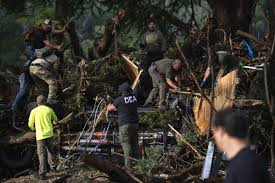Texas flash flood death toll surpasses 100 as 5 million in central Texas remain under flood watch

Texas Flash Flood Death Toll Surpasses 100: Widespread Danger Continues
The Texas flash flood death toll has now surpassed 100, following relentless rainstorms that devastated the central region over the July 4 weekend. Authorities confirmed at least 104 deaths, including 28 children, while emergency responders continue searching for dozens of missing individuals. Despite receding waters in some areas, over 5 million Texans remain under flood watch as officials brace for more rain.
Families Grieve as Communities Reel from Devastation
Tragedy struck hardest at Camp Mystic, a summer retreat in Kerr County, where raging waters overwhelmed cabins and swept away campers in the middle of the night. The Guadalupe River rose rapidly, leaving little time for evacuation. So far, officials have counted 84 deaths in Kerr County alone.
Many families still await news about their loved ones. “I sent my daughter to camp thinking she’d have the summer of her life,” said Laura Bennington, whose 13-year-old remains missing. “No parent should go through this. They didn’t even warn us.”
Several other counties, including Burnet, Travis, Tom Green, and Williamson, also reported fatalities. In many areas, rescue teams continue recovering bodies from flooded roads and rivers.
Millions Remain Under Flood Watch as Rescues Continue
While skies have partially cleared, meteorologists warn that the flood threat continues. The National Weather Service extended flood watches across central Texas, covering cities such as San Antonio, Austin, and San Angelo. Since the storm began, over 850 people have been rescued, but at least 25 others remain unaccounted for.
Rescue workers face major challenges due to blocked roads, unstable terrain, and limited daylight. In one instance, a drone collided with a rescue helicopter, forcing a temporary suspension of operations.
“We are racing against time,” said Lt. Mark Hensley of the Texas State Guard. “Every hour counts.”
Lack of Warning Systems Fuels Public Outrage
As grief turns to anger, residents have begun demanding accountability. Despite being flood-prone, Kerr County had no flood sirens or automated public alerts in place when the waters surged. Investigations revealed that county officials had previously declined federal funds for emergency systems.
“We never got a warning,” said Maria Estrada, a local resident who lost two family members. “People drowned in their beds.”
In response, Lieutenant Governor Dan Patrick announced that all flood-risk counties will receive funding to install sirens before next summer. “We failed to protect our people, and that must change,” he admitted during a press conference.
Extreme Weather Fueled the Catastrophe
Meteorologists link this flood to a mesoscale convective system that stalled over the Texas Hill Country, dumping over 20 inches of rain within 48 hours. The storm system, fueled by remnants of Tropical Storm Barry, overwhelmed rivers and stormwater infrastructure.
“This wasn’t just bad weather—it was a historic event,” said Dr. Elena Gutierrez, a climate scientist at the University of Texas. “Because of climate change, storms like this will become more intense and frequent.”
Billions in Damages and a Long Road to Recovery
In addition to the heartbreaking human toll, the floods have caused between $18 and $22 billion in damages, affecting homes, roads, crops, and power grids. Thousands of homes remain without electricity. Many rural roads have been washed away or rendered unusable.
President Trump plans to visit the affected areas later this week, alongside FEMA Director Janet Ross, to survey the damage and coordinate federal relief. Meanwhile, shelters across Texas continue housing thousands of displaced residents.
Volunteers, including many from neighboring states and Mexico, are helping distribute food, medical supplies, and clean water. Their rapid response has been praised by local leaders.
Stories of Courage Offer Hope Amid Tragedy
Even in the midst of devastation, Texans have shown resilience. In Burnet County, a mail carrier used his delivery van to transport stranded families to safety. Meanwhile, in San Angelo, high school students formed a human chain to rescue an elderly couple trapped on a rooftop.
“These are the moments that remind us of who we are,” said Mayor Vanessa Hsu of San Angelo. “When everything falls apart, we hold each other up.”
Urgent Calls for Change and Preparedness
Experts and community leaders agree: Texas must invest more in flood preparedness. They urge the state to upgrade drainage systems, expand floodplain mapping, and install real-time alert mechanisms.
“This disaster should serve as a wake-up call,” said Dr. Gutierrez. “The water came fast, but our readiness came too late.”
Local governments are now reviewing flood response plans. Advocacy groups are also pushing for legislation that requires flood warning systems in all high-risk counties.
What Lies Ahead
Although search-and-rescue teams continue their work, focus is shifting toward recovery and rebuilding. State and federal aid will provide some relief, but long-term solutions remain critical.
With over 100 lives lost and millions still at risk, Texas faces a defining moment. How leaders respond now may shape the region’s resilience for decades to come.






